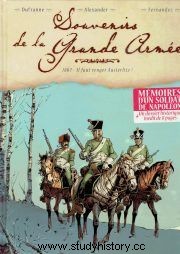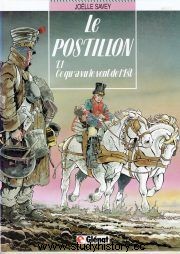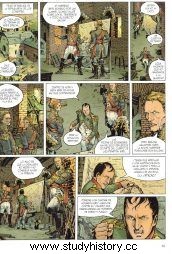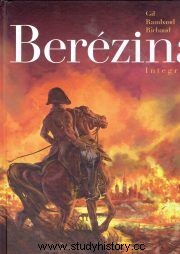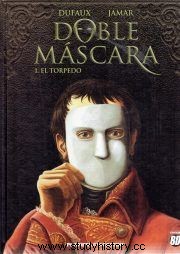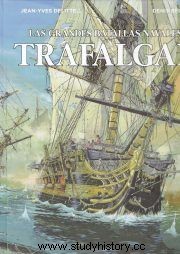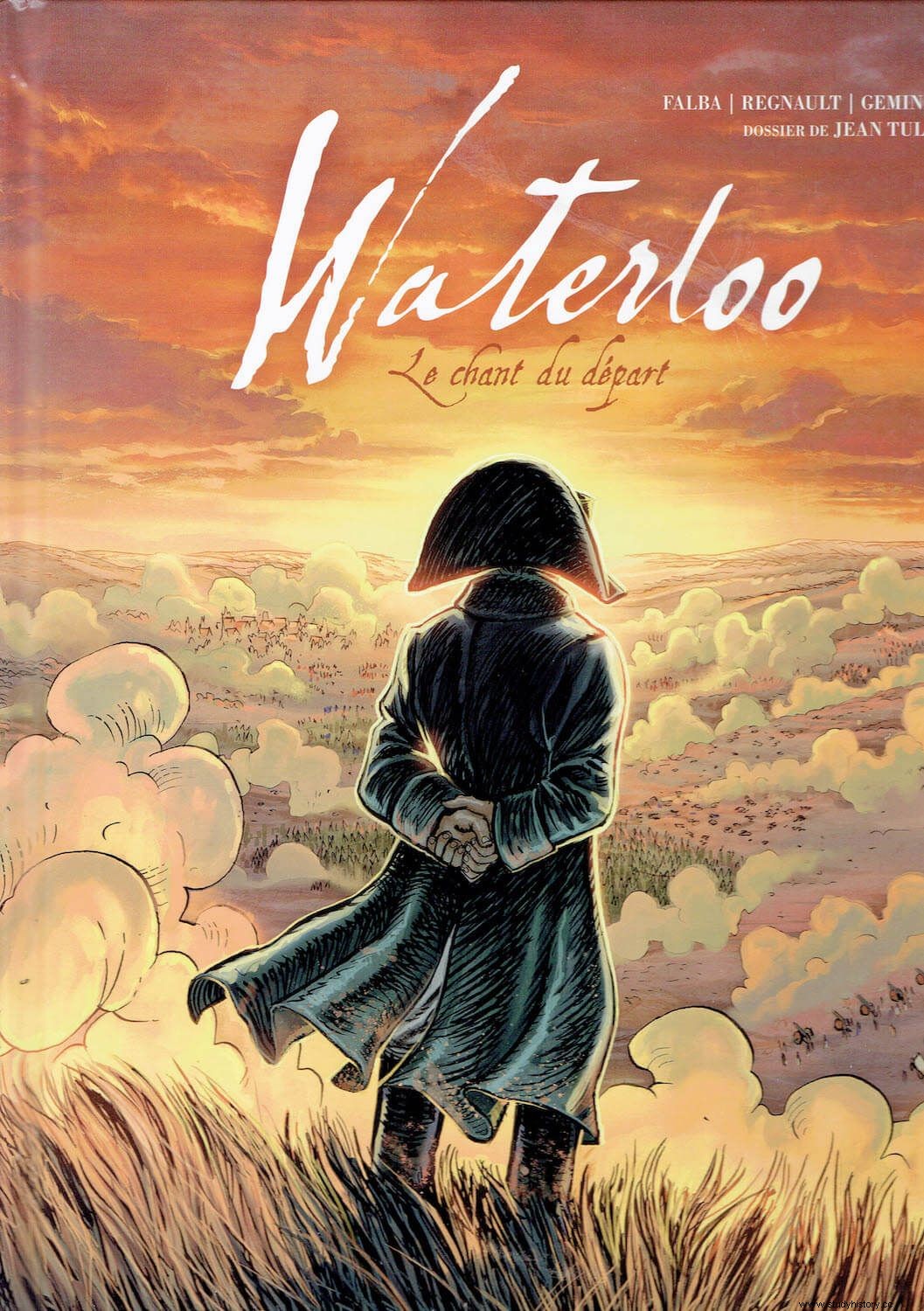
Following the model of the series of the French editorial production , Dominique Bertail, assisted by Matz as screenwriter, submitted Shandy. Un anglais dans l'Empire focused on the adventures of a young Englishman from a noble family who, passionate about the figure of the Emperor, will enlist in the French army, participating in various political intrigues that will culminate in his participation in the Battle of Austerlitz throughout two volumes:Agnes and Le Dragon d'Austerlitz both published in 2006 by Delcourt (Fig. 1). The books are an example of a lack of rigor both in the historical framework when recounting the development of the battle, and especially in the uniformology, with gross errors such as placing the Red Lancers or the line lancers in 1805, regiments that would be organized years later, or the uniformity of the French infantry, dressed according to the regulations of 1807 and 1812, some absolutely incomprehensible errors considering the large amount of information available. The publisher Delcourt recognized the error by canceling the series, and radically modified the model by starting a new one in 2007:Souvenirs de la Grande Armée , with a script by Michel Dufranne, drawings by Alexis Alexander and colors by Jean-Paul Fernández, of which four installments have been published:1807. Il faut venger Austerlitz!; Les enfants de la veuve (2008); Vienne ou mourir! (2010) and Les chasses du comte Joukhov (2012). The plot focuses on the memories of an officer of the 2nd Horse Chasseurs who reviews his campaigns between the preliminaries of the Battle of Eylau (1807) and the withdrawal from Russia in 1812 (Fig. 2). Although the drawing and the composition of the pages have a contemporary air, far from the classicism of the Funcken drawing, the documentation is excellent and the reconstruction of characters and scenes very believable, being interesting that each book contains an explanatory dossier:On the traces of the Grande Armée, and a glossary to contextualize the plot, in addition to reproducing a certain number of sketches that show the evolution of the drawing during the creation process.
- Figure 1
- Figure 2
We will have to wait until 2015 for the publication of a new album about Waterloo under the bicentennial:Waterloo. Le chant du départ , edited by Glénat. With a script by Bruno Falba, a story board by Christophe Regnault and drawings by Maurizio Geminiani, it narrates the events of the 1815 campaign through the recreation of the interview between Baron Larrey and Blücher when the former was captured by the Prussians during the withdrawal from the battlefield. A known fact that serves as a starting point for the narrative of the impact on Europe of Napoleon's return from the island of Elba and the campaign. The volume also has a documentary dossier written by Jean Tulard, one of the most prestigious experts on the Napoleonic era. However, the work, in which uniformological errors unbecoming of a serious documentation work as would have been desirable in a prestigious publishing house such as Glénat, can be seen, disappoints both for its script and for the drawing and composition of the plates (Fig. 3).
Unlike it might seem, Napoleonic comics are not conceived in France exclusively as a glorification of the Empire. On the contrary, the criticism of ten years of successive wars , to the human and economic exhaustion caused by the campaigns, and the two invasions that France had to endure in 1814 and 1815, driven by the questioning of the meaning and benefits of the imperial epic, are present in several series. The first in time, Le postillion , with script and drawings by Joëlle Savey, edited by Glénat between 1990 and 1993, shows the impact of the 1814 campaign on the levy of the María-Luisa and the civilian population under the Prussian and Russian occupation in four books: Ce qu'a vu le vent de l'Est; La porte du temps; Le chants des escoliers and Parfums d'enfer , using an employee of the French post office as the narrator to show, ultimately, the desperation of the Bonapartists after the abdication and the need to rebuild the country (Fig. 4). A second series:Les oubliés de l’Empire , with a script by Dimitri, drawings by Philippe Eudeline and colors by Véronique Robin, focuses on the figure of young people who, encouraged by the revolutionary impulse and the success of Bonaparte's campaigns in Italy, enlisted in the army in search of the glory to discover, after bitter experiences, that it is not glory, but death and despair, that awaits the recruits. Cannon fodder for the Empire narrated in three albums:Poussières de gloire (2008); Du sang in Andalousie (2009) and Les dammés (2010). With drawings by Eudeline, colors by Robin and script by Pascal Davoz, another series:La Gloire des Aigles , edited by Joker, develops the same critical scheme using the character of a young drummer during the withdrawal from Russia and the campaign of 1813 and 1814, visualizing it in two albums:Sauve la vie (2014) and Maion Lagriotte (2016), to the members of an age group, adolescents almost children, who participated and died in the Napoleonic wars, as demonstrated at the beginning of this century by the paleanthropological analyzes of the human remains located in the excavation of the mass graves of Vilnius (Lithuania), where hundreds of Napoleonic soldiers killed in the final phase of the Russian campaign were buried.
- Figure 3
- Figure 4
Another interesting section is the translation of literary works into comics. From the story The duel (1907) by Joseph Conrad (1857-1924), Renaud Farace reconstructs in Duel (2017)[1] the vicissitudes of the famous confrontation between generals D'Hubert and Féraud, a transcript respectively of Pierre-Antoine Dupont de l'Étang (1765-1840) and François Fournier-Sarlovèze (1773-1827), between 1794 and 1813, captured with great success in Ridley Scott's film, The Duelists (1977). It has a solid script, and the peculiarity of being edited in two colors, in black and white/red, for which it proposes a very simple and to a certain extent caricatured drawing that is appreciated or rejected, but that in any case forms a remarkable work (Fig. 5). Patrick Rambaud won the Grand Prize for Novel at the Académie Française and the Prix Goncourt in 1997 with his novel La Bataille , in which he narrated, based on the figure of the military man and painter Louis-François Lejeune, one of the great chroniclers of the time in his canvases, the battle of Aspern-Essling, Napoleon's first failure in his attempt to obtain a decisive victory over the Austrians in the campaign of 1809. It was the beginning of a tetralogy that would continue with the works Il neigeait (2000), L'absent (2003) and Le chat botté (2006). With the advice of the author, Frédéric Richaud made an adaptation of the story published in three volumes between 2012 and 2014 by the Dupuis publishing house[2], with drawings by the Spanish Iván Gil and coloring by Albertine Ralenti (Fig. 6). In this case, the setting is excellent and faithful to the content and spirit of the original, perfectly mixing historical characters such as Berthier, Masséna, Dorsenne, Bessières or Henri Beyle, Stendhal , with other fictional ones that run through the ranks of the French army and the Viennese social classes, in an interesting contrast between the horror of the fight and the relaxation of worldly pleasures, both close and distant. An exceptional work that had its continuation in the adaptation of Rambaud's second story, set in the retreat from Russia, and published in three volumes between 2016 and 2018,[3] in which the lives of soldiers and civilians during the conflict, the desperation and meaninglessness of war, exemplified in the broken figure of Captain D'Herbigny returned from said one-armed hell, disfigured and close to madness, doomed to a miserable life as a symbol of endless war. Both volumes have complementary explanatory documentation to frame the story, especially the first, in a dossier with the title From Essling to Waterloo (Fig.7)
- Figure 5
- Figure 6
- Figure 7
The fate of the men of the Grande Armée after the end of the Empire, the so-called démi-soldes, soldiers sent into retirement with half pay for his disaffection with the Bourbons and the reorganization of the army after the definitive return of the emigrants in 1815, whose experiences have fed a part of the French novel of the 19th century, is reflected in Le Vétéran (2017)[4] a work in two volumes edited by Glénat with a script by Frank Giroud, drawings by Gilles Mezzomo and colors by Céline Labriet, somewhat reminiscent of Honoré de Balzac's story, Colonel Chabert (1832). An officer of the 7th Hussars who has lost his memory as a result of a wound received at Waterloo, is identified in a Paris hospital by his wife and led to a life of which he remembers nothing as the beginning of an intrigue in which memories of the Empire are mixed with the social changes of the Restoration, a work that, like others already mentioned, suffers from setting errors, especially in the field of uniforms, as the plot is prioritized over the reconstruction of the time (Fig. 8 ).
The fact that several of the characters from the previous story end up joining together to form a company of private detectives, links to another of the characteristic plot lines of the comic set in the Napoleonic era :the underworld of crime and espionage , whose precedent can be found in the work of Hans Kresse, Les aventures de François Vidocq (1977) about the famous convict-turned-investigator in Paris at the beginning of the Empire, who is credited with founding the Sûreté Nationale and developing private investigation in the second quarter of the 19th century, and on whose life Edgard Allan Poe (1809-1849) for the creation of the character of Auguste Dupin, and especially Victor Hugo (1802-1885) for those of Jean Valjean and Inspector Jabert in the novel Les Miserables . Vidocq gives name to a recent series of the same name edited by Soleil, with a script by Richard Nolane, drawings by Sinisa Banovic and colors by Matteo Vattani, centered on a series of murders in Paris during the fall of the Empire between 1813 and 1814, over three albums:Le suicidé de Notre-Damme (2017); The Napoleon plot (2017) and Le cadavre des Illuminati (2019).
The idea of a character like Vidocq struggling between legality and the underworld is reflected in the series Double Masque in the character of the ruffian known as El torpedo , who will end up working as an agent for the first consul Bonaparte (Fig. 9). The series, with a script by Jean Dufaux and drawings by Martin Jamar, lasted through six albums:La torpille (2004); The fourmi (2005); L'archifou (2006); Les deux sauterelles (2008); Les coqs (2011) and L'hermine (2013), showing a different vision of the political, economic and social intrigues of the Napoleonic stage . A resource that of the secret agents at the service of the emperor that had already been explored in the series François Jullien , with drawings by Jamar himself and a script by Franklin Dehouse, between 1985 and 1991 in five books that cover the period between the end of the consulate and the Austrian campaign in 1809, when the series was interrupted after the installments were published:The refractory (1985); Le messager anglais (1986); Sur les routes d’Espagne (1988); Le diable Boileux (1990) and Nuits viennoises (1991).
- Figure 8
- Figure 9
Recourse to secret agents allows us to link with another scenario of the Napoleonic wars:the naval battles . On the album Trafalgar , edited by Glénat within the series Les Grandes Batailles Navales ,[5] two spies inform the Minister of Foreign Affairs, Charles Maurice de Talleyrand (1754-1832) of the execution of the order to assassinate in Rennes, in April 1806, Admiral Pierre de Villeneuve, responsible for the naval defeat of the Franco-Spanish squad before Horatio Nelson's army on October 21, 1805, found dead with six stab wounds to the chest although his death was ruled a suicide. The series has the support of the Musée national de la Marine de France and includes a historical dossier that contextualizes the battle by explaining various aspects of naval life at the beginning of the 19th century, reaffirming its didactic nature. With a script by Jean-Yves Delitte and drawings by Denis Béchu, the album shows both the life of the crews on the French ships and the discussions in the British navy to force the departure of the combined fleet from the port of Cádiz, and the doubts and the inexperience of Villeneuve, whose heroic and committed counterpart is the captain of the Redoutable, Jean-Jacques Lucas. Despite the documentary effort, the authors minimize the importance of the Spanish ships and commanders; they present Villeneuve as a relaxed satrap lodged in a Cadiz palace with clear reminiscences of the Alhambra's Patio de los Leones, and include various commando actions by the British marines on the Spanish coast, through which infantry units from French line and hunters on horseback… in 1805! (Fig. 10).
But, without a doubt, the main naval character in the comics referring to the period is the British naval officer Bruce J. Hawker , protagonist of the homonymous series. Created for Tintin magazine by Belgian William Vance (William van Cutsem, 1935-2018), one of the main Franco-Belgian clear line writers and cartoonists, author of series such as XIII or Bruno Brazil , the series, which, once advanced, will feature the scripts by André-Paul Duchâteau and the coloring by the Spanish Petra Coria, narrates in seven installments:Cap sur Gibraltar (1883); L’orgie des dammés (1984); Press gang (1987); The puzzle (1987); Tout ou rien (1988); Les bourreaux de la nuit (1991) and Le royaume des enfers (1996)[6], the adventures of a lieutenant whose determination to do what he considers his duty, and the lax interpretation he makes of orders, clearly refers to the great series of novels and characters of the naval adventures of the period, such as the canonical ones starring Horatio Hornblower, by Cecil Scott Forester (1899-1966), and the more bizarre ones by Jack Aubrey in the creation of Patrick O'Brian (1914-2000) (Fig. 11).
- Figure 10
- Figure 11
The Napoleonic-themed comic It currently has an estimable presence in the Franco-Belgian publishing world within a production in which albums with a historical theme are highly appreciated and the number of series is high. In this brief review we have made reference to some of the most outstanding, but the number of examples is much higher, with productions focused on the biography of various characters such as General Marcellin de Marbot (1782-1854) made from his memoirs embodied in seven installments by Stéphane Pêtre edited between 2006 and 2013, or the recent reinterpretations of the figure of Napoleon such as the volume De Bonaparte à Napoléon. L'ascension 1769/1804, edited in 2020 by Hachette, the Napoléon published by Fayard in 2019, or the three books dedicated to the character in the collection Ils ont fait l’Histoire edited between 2014 and 2016 by Glénat and Fayard with a script by Noël Simsolo, drawings by Frabrizio Fiorentino and colors by Alessia Nocera, a work for which they once again collaborated with Jean Tulard. Without forgetting an interesting biography of Marie Thérèse Figueur (1774-1861), one of the few women enlisted in the French army at the time, whose adventures are reconstructed by the screenwriter Damien Marie and the cartoonist Karl T. in the album Thérèse Dragon . Récit des campagnes napoléoniennes , structured from her memoirs that include her capture in the vicinity of Burgos due to the departure of the priest Merino and her subsequent delivery to the English, one of the few examples in which a woman is the protagonist of the work, given that in most of those indicated their role is strictly secondary.
Notes
[1] Edited in Spanish, Duelo (2018), Speaker Mon Editions.
[2] Edited in Spanish in full format with the title The Battle by Ponent Mon in 2017.
[3] Edited in Spanish in full format with the title Berézina by Ponent Mon in 2018.
[4] Edited in Spanish in full format with the title The veteran by Ponent Mon in 2019
[5] The series is being edited in Spain by Norma Editorial.
[6] The first two volumes were published in Spain by Editorial Bruguera in 1983-1984. Ponent Mon has published an integral with the seven installments in 2018.


